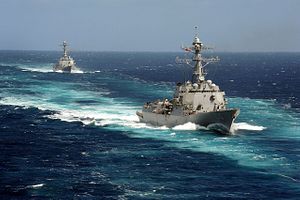China is not happy with the implementation of a 2014 basing agreement between the United States and the Philippines that will see the U.S. military receive rotational access to bases across the Philippines. Under the Enhanced Defense Cooperation Act (EDCA), which was signed in 2014 and upheld under the Philippines’ constitution by the country’s Supreme Court in January 2016, U.S. forces will have access to Antonio Bautista Air Base, Basa Air Base, Fort Magsaysay, Lumbia Air Base, and Mactan-Benito Ebuen Air Base.
The Chinese foreign ministry had words of caution for Washington and Manila. In a response to a question from a reporter during a press conference, Hua Chunying, a spokesperson for the Chinese foreign ministry, said that the “the U.S.-Philippines cooperation should not target a third party, even less jeopardize the sovereign and security interests of other countries or affect regional peace and stability.”
She additionally reiterated Beijing’s view that contrary to assertions in Washington and in regional capitals, it is the United States that is responsible for the militarization of the South China Sea: “I also want to mention that the US military has kept talking about the so-called militarization in the South China Sea. Maybe they can explain whether their increased military deployment in the South China Sea and nearby areas is an action of militarization or not?”
As my colleague Prashanth Parameswaran explained last week, the implementation of the EDCA–though a nuanced and gradual process–will be a significant development for the United States. Additionally, for the Philippines, the EDCA will allow the United States to buttress the country’s relatively modest military capabilities. The agreement was concluded during U.S. President Barack Obama’s April 2014 trip to Asia; I described it then as a boon to the administration’s rebalance to Asia.
Carl Thayer, an analyst of regional security issues, underlined in 2014 in The Diplomat, shortly after the agreement was signed, that the primary ambiguity of the EDCA would be its effectiveness in forestalling expansionary behavior by the Chinese Coast Guaard in the South China Sea. Recent evidence from waters off the Philippines’ coast and even the Indonesian coast show that this unlikely to be the case anytime soon. China’s assertiveness has remained constant and, in some cases, intensified in the months since the EDCA was signed.
From China’s perspective, the coming implementation of the EDCA will add to fears that the United States is moving to effectively encircle it in the South China Sea. As The Diplomat has catalogued, China’s assertive behavior in the South China Sea, including the construction of artificial islands and emplacement of military assets, has forced the United States to increase its activities in the region and upgrade its regional alliances and partnerships.
In the case of the Philippines, the EDCA represents a partial return to the status quo pre-1992, when the United States maintained a permanent naval base at Subic Bay. Though the EDCA is a more limited and time-bound rotational basing arrangement, it will mark a return of sorts for the U.S. military. That’s good news for observers in Washington who have been eager to see dividends on the Obama administration’s rebalance to Asia, but an unwelcome development for China, which sees the EDCA as a springboard to containment.

































